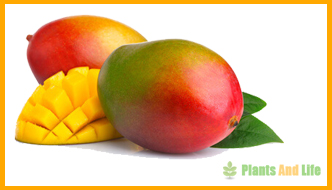
The mango is the fruit of the mango tree, a large tropical tree in the Anacardiaceae family, native to the forests of India, Pakistan and Burma where it still grows in the wild.
This tree, Mangifera indica, has evergreen, dense and dark green foliage. The shape of its fruit is the basis of the cashmere motif.
Its name comes from the Portuguese manga, taken from malayalam മാങ്ങ, māṅga, which comes from Tamil மாங்காய், māṅgāy.
The fruits of other trees, of the genus Irvingia (wild fruits with black spots and their flesh is of a beautiful orange color and an exquisite scent) are called wild mangoes, attached to the family of Irvingiaceae.
Description
It is a drupe, its flesh adheres to a large, flat and slippery core. It can be round, oval or kidney shaped, and has a bark which can be yellow, green or red, which it is necessary to remove, because it contains irritating substances and is therefore not edible.
Its flesh is dark yellow, creamy, oily and sweet with a false taste of peach and flower. Depending on the variety or when the fruit is too ripe, the flesh sometimes becomes stringy.
For alimentation
Mango is eaten all over the world, but it is really delicious only when picked and therefore eaten close to where it grows. The mango is ripe when it yields under slight pressure from the fingers and a heady fragrance emerges, or, almost certainly, when traces of sugar are visible at the base of the tail. The taste of the mango depends on the variety and the maturity; you can find flavors of peach, flowers, lemon, apricot, banana, mint ... or even turpentine.
It can be eaten plain or incorporated into fruit salads, cereals and sorbets. You can turn it into coulis or make jam. It is usually used, in dry and ground form, in many vegetable dishes of northern Indian cuisine to give a bit of bitterness where it is called amchur (sometimes written amchoor), am being the Hindi word for "Mango". It is delicious with poultry, duck and pork. In the Mascarenes, green mango can be used for a spicy rougail which will accompany meat dishes.
Green mango chutneys are sweet condiments made from mango and various spices. They accompany curry dishes, cold meat or cheeses. There are several recipes for mango chutneys, depending on Jamaican or Indian origin.
The fat from the mango core is incorporated into certain foods such as chocolate.
The mango is prone to many fungi such as anthracnose or parasites such as the mango fly or the mango kernel weevil. Climatic disturbances are the main cause of most of these diseases, mainly mango flies.
History
In the 16th century, the Mughal emperor Akbar had an orchard of 100,000 mango trees planted in the gardens of Darbhanga.
From Africa, the Portuguese bring it to Brazil and it spreads to the New World. The first crops in Florida, due to Dr. Henry Perine, date from 1833, the fruit reached California in the 1880s.
Today, the mango is cultivated in all tropical and subtropical countries of the globe, and there are several hundred different species known, of which only a few are marketed.
In the state of Punjab in India, at Burail, grows a mango tree 20 m high, 10 m in circumference, endowed with branches of 4 m in circumference and more than 25 m in length4, which yields 17,000 kilos of mangoes per year.


